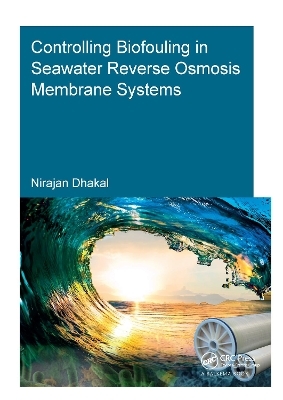
Controlling Biofouling in Seawater Reverse Osmosis Membrane Systems
Crc Press Inc (Verlag)
9780815357186 (ISBN)
This research focused on assessing the ability of UF and other pre-treatment technologies to reduce biofouling in SWRO systems. An improved method to measure bacterial regrowth potential (BRP) was developed and applied at laboratory, pilot and full scale to assess the ability of conventional UF (150 kDa) and tight UF (10 kDa) alone and in combination with a phosphate adsorbent to reduce regrowth potential and delay the onset of biofouling in SWRO.
The improved bacterial regrowth potential method employs a natural consortium of marine bacteria as inoculum and flow cytometry. The limit of detection of the BRP method was lowered to 43,000 ± 12,000 cells/mL, which is equivalent to 9.3 ± 2.6 µg-Cglucose/L.
The reduction in bacterial regrowth potential after tight UF (10 kDa) was 3 to 4 times higher than with conventional UF (150 kDa). It was further reduced after the application of a phosphate adsorbent, independent of pore size of the UF membrane. Pilot studies demonstrated that the application of tight UF (10 kDa) coupled with a phosphate adsorbent consistently lowered the bacterial regrowth potential and no feed channel pressure drop increase was observed in membrane fouling simulators (MFS) over a period of 21 days. The study also showed that non-backwashable fouling of UF membranes varied strongly with the type of algal species and the algal organic matter (AOM) they release. The presence of polysaccharide (stretching -OH) and sugar ester groups (stretching S=O) was the main cause of non-backwashable fouling.
In conclusion, this study showed that an improved BRP method is suitable for the assessment of SWRO pre-treatment systems and it can be a useful tool to develop potential strategies to mitigate biofouling and improve the sustainability of SWRO systems.
Nirajan Dhakal is a Lecturer in Water Supply Engineering at IHE-Delft Institute for Water Education in the Netherlands. He completed his MSc degree in Water Supply Engineering at UNESCO-IHE in 2011 and he will be awarded with a PhD degree at the Technical University of Delft on November 2017. He has a second MSc degree in Regional Development Planning and Management from the University of Dortmund, Germany, and University of the Philippines in 2009. He has more than 6 years of consultancy and research experience in water supply engineering. For the last 5 years, Nirajan has been involved in various research projects related to algal blooms and membrane based seawater desalination in collaboration with the Wetsus European Centre of Excellence for Sustainable Water Technology. He is broadly interested in desalination with particular emphasis on algal blooms and membrane fouling and scaling mechanisms, mitigation, and control, pre-treatment technologies and modelling.
1 General introduction
2 Perspective and challenges for desalination
3 Measuring bacterial regrowth potential (BRP) in seawater reverse osmosis using a natural bacterial consortium and flow cytometry
4 Understanding ultrafiltration membrane fouling induced by four marine bloom forming algae
5 The role of tight UF on reducing the bacterial regrowth potential of SWRO feed water
6 Phosphate removal in seawater reverse osmosis feed water: An option to control biofouling
7 General conclusions and future perspective
| Erscheinungsdatum | 22.01.2018 |
|---|---|
| Reihe/Serie | IHE Delft PhD Thesis Series |
| Verlagsort | Bosa Roca |
| Sprache | englisch |
| Maße | 174 x 246 mm |
| Gewicht | 580 g |
| Themenwelt | Naturwissenschaften ► Biologie ► Ökologie / Naturschutz |
| Naturwissenschaften ► Geowissenschaften ► Hydrologie / Ozeanografie | |
| Technik ► Umwelttechnik / Biotechnologie | |
| ISBN-13 | 9780815357186 / 9780815357186 |
| Zustand | Neuware |
| Informationen gemäß Produktsicherheitsverordnung (GPSR) | |
| Haben Sie eine Frage zum Produkt? |
aus dem Bereich


